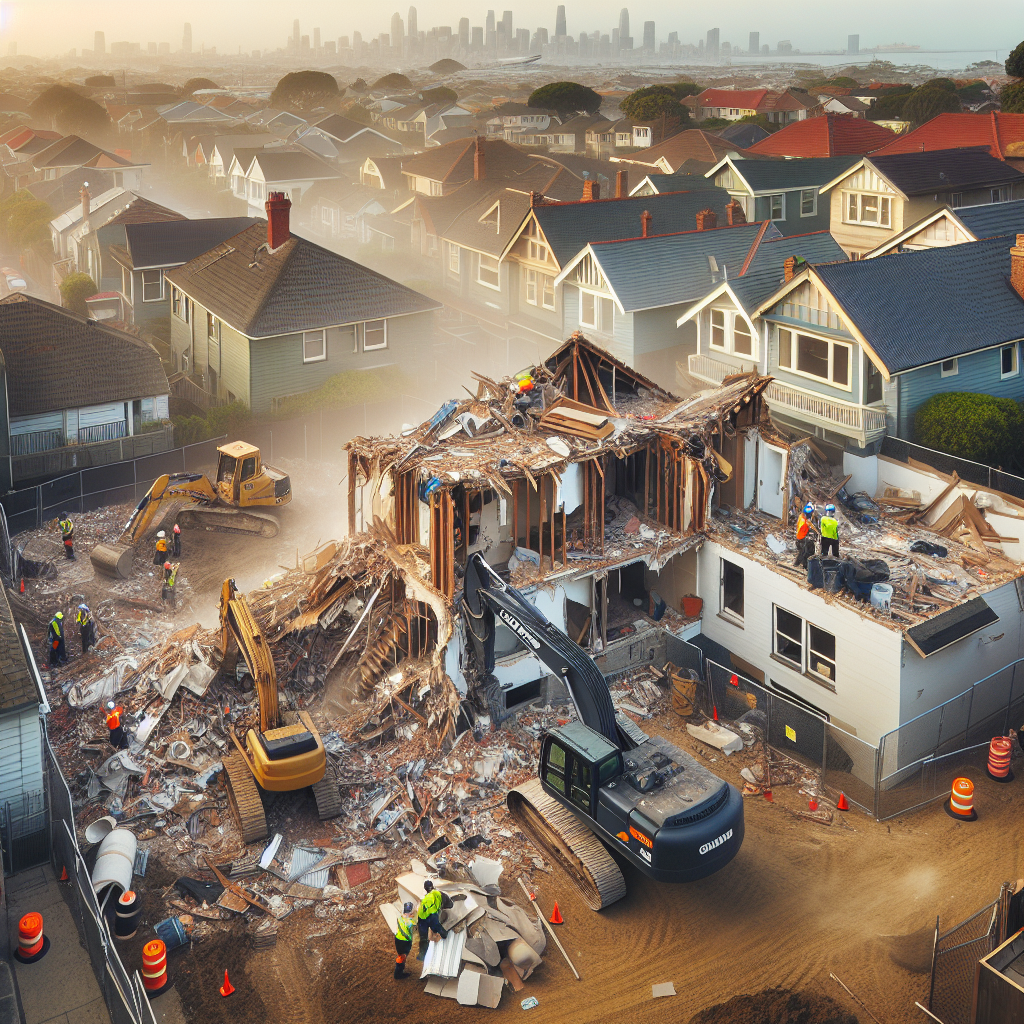Demolition and Site Preparation for Knock Down Rebuilds
-
Table of Contents
Demolition and site preparation are critical phases in the process of knock down rebuilds, where an existing structure is demolished to make way for a new construction. This process begins with a thorough assessment of the existing building, including structural integrity, hazardous materials, and utility disconnections. Once the site is cleared of any salvageable materials and hazardous substances, heavy machinery is employed to demolish the structure safely and efficiently. Following demolition, the site is meticulously prepared for new construction, which involves grading the land, ensuring proper drainage, and laying the groundwork for utilities. This foundational work is essential to ensure the stability and longevity of the new build, setting the stage for a successful construction project.
Essential Steps in Demolition for a Successful Knock Down Rebuild
Demolition and site preparation are critical components in the process of a knock down rebuild, ensuring that the new construction can proceed smoothly and safely. The initial phase of demolition involves a comprehensive assessment of the existing structure. This assessment is crucial as it identifies any hazardous materials, such as asbestos or lead paint, which must be handled with care and in compliance with local regulations. Engaging a professional demolition contractor who is well-versed in these regulations is essential to mitigate any health risks and legal complications.
Following the assessment, obtaining the necessary permits is the next step. This process can be intricate, requiring detailed documentation and adherence to municipal codes. It is advisable to work closely with local authorities to ensure all permits are secured before any physical work begins. This not only prevents potential legal issues but also ensures that the demolition process adheres to safety standards.
Once permits are in place, the site must be prepared for demolition. This involves disconnecting utilities such as water, gas, and electricity to prevent any accidents during the demolition process. Additionally, securing the site with appropriate fencing and signage is important to protect both workers and the public. This step also includes salvaging any materials that can be reused or recycled, which not only reduces waste but can also provide cost savings.
The actual demolition can then commence, typically starting with the removal of non-structural elements like windows, doors, and fixtures. This is followed by the systematic dismantling of the structural components. Using heavy machinery such as excavators and bulldozers, the building is carefully brought down. Throughout this process, dust and debris control measures must be in place to minimize environmental impact and ensure the safety of the surrounding area.
After the structure has been demolished, the site must be cleared of all debris. This involves sorting materials for recycling and proper disposal of waste. It is important to adhere to environmental regulations during this phase to avoid any penalties and contribute to sustainable practices. The cleared site is then graded and leveled, providing a stable foundation for the new construction.
Site preparation also includes soil testing to ensure that the ground is suitable for the new build. This may involve geotechnical assessments to identify any potential issues such as soil instability or contamination. Addressing these issues beforehand is crucial to prevent future structural problems. If necessary, soil remediation or reinforcement techniques can be employed to enhance the site’s suitability.
Finally, the site is ready for the new construction to begin. This involves setting up the necessary infrastructure, such as temporary utilities and access roads, to facilitate the building process. Proper planning and coordination with construction teams are essential to ensure a seamless transition from demolition to building.
In conclusion, the essential steps in demolition for a successful knock down rebuild encompass a thorough assessment, securing permits, site preparation, systematic demolition, debris clearance, and soil testing. Each step is interconnected, requiring meticulous planning and execution to ensure the safety, compliance, and efficiency of the project. By adhering to these steps, homeowners and builders can pave the way for a successful and sustainable new construction.
Site Preparation Best Practices for Knock Down Rebuild Projects

When embarking on a knock down rebuild project, meticulous site preparation is paramount to ensure a smooth and successful construction process. The initial phase of site preparation involves a comprehensive assessment of the existing structure and the surrounding environment. This assessment is crucial as it identifies potential hazards, such as asbestos or lead-based paint, which must be addressed before demolition can commence. Engaging a qualified inspector to conduct this evaluation ensures that all safety and environmental regulations are adhered to, thereby mitigating any risks associated with hazardous materials.
Following the assessment, obtaining the necessary permits and approvals from local authorities is a critical step. This process can be time-consuming, but it is essential to comply with zoning laws, building codes, and other regulatory requirements. Securing these permits not only legitimizes the project but also helps avoid legal complications that could delay or halt the rebuild.
Once the legalities are in order, the next step is to disconnect and safely remove all utilities, including water, gas, electricity, and sewage systems. Coordinating with utility companies to ensure a systematic disconnection is vital to prevent accidents and ensure the safety of the demolition crew. Additionally, it is advisable to notify neighboring properties about the upcoming demolition to minimize disruptions and maintain good community relations.
The actual demolition process should be carried out by experienced professionals who are well-versed in the latest demolition techniques and safety protocols. Employing advanced machinery and equipment, such as excavators and bulldozers, facilitates efficient and controlled demolition. It is also important to implement dust control measures, such as water spraying, to minimize airborne particles that could pose health risks to workers and nearby residents.
Post-demolition, the site must be cleared of debris and any remaining hazardous materials. Proper disposal of these materials in accordance with environmental regulations is essential to prevent contamination and ensure a clean slate for the new construction. Recycling salvageable materials, such as metal and concrete, not only reduces waste but also contributes to sustainable building practices.
With the site cleared, the focus shifts to soil testing and land surveying. Soil testing determines the soil’s composition and stability, which are critical factors in designing the foundation of the new structure. Land surveying, on the other hand, provides precise measurements and mapping of the site, ensuring that the new build aligns with property boundaries and complies with zoning regulations.
Subsequently, site grading and leveling are performed to create a stable and even surface for construction. This involves reshaping the land to facilitate proper drainage and prevent water accumulation, which could compromise the integrity of the new building. Implementing erosion control measures, such as silt fences and retaining walls, further protects the site from soil erosion during and after construction.
Finally, establishing a robust site management plan is essential to coordinate the various activities and ensure that the project stays on schedule and within budget. This plan should outline the roles and responsibilities of all stakeholders, including contractors, suppliers, and inspectors, and include contingency measures to address any unforeseen challenges.
In conclusion, thorough site preparation is the cornerstone of a successful knock down rebuild project. By adhering to best practices, from initial assessment to site management, project stakeholders can ensure a safe, efficient, and compliant construction process that lays the foundation for a durable and sustainable new structure.
Safety Considerations During Demolition and Site Preparation
Safety considerations during demolition and site preparation are paramount, particularly in the context of knock down rebuilds. The process of demolishing an existing structure and preparing the site for new construction involves numerous hazards that must be meticulously managed to ensure the safety of workers, the public, and the environment. To begin with, a comprehensive risk assessment is essential. This involves identifying potential hazards, evaluating the risks associated with those hazards, and implementing control measures to mitigate them. For instance, the presence of hazardous materials such as asbestos, lead, or mold must be identified and safely removed by certified professionals before any demolition activities commence.
Moreover, securing the site is a critical step in maintaining safety. Erecting barriers and signage to prevent unauthorized access can help protect the public from potential dangers. Additionally, ensuring that all workers are equipped with appropriate personal protective equipment (PPE) such as hard hats, gloves, safety glasses, and steel-toed boots is crucial. This not only protects individuals from physical injuries but also from exposure to harmful substances.
Transitioning to the actual demolition phase, it is vital to employ controlled demolition techniques. This involves using methods that minimize the risk of uncontrolled collapse and debris scatter. For example, mechanical demolition using excavators and bulldozers should be conducted in a systematic manner, starting from the top of the structure and working downwards. This approach helps to maintain structural stability and reduces the likelihood of accidents. Furthermore, continuous monitoring of the structure’s integrity during demolition is necessary to promptly address any emerging risks.
In addition to structural concerns, managing dust and noise pollution is another significant safety consideration. Dust generated during demolition can pose respiratory hazards to workers and nearby residents. Implementing dust suppression measures such as water spraying and using dust barriers can effectively mitigate this risk. Similarly, noise pollution can have detrimental effects on hearing and overall well-being. Utilizing noise-reducing equipment and scheduling noisy activities during less disruptive times can help manage this issue.
As the site transitions from demolition to preparation for new construction, attention must be given to the safe removal and disposal of debris. Properly segregating materials for recycling and disposal not only promotes environmental sustainability but also reduces the risk of accidents caused by cluttered workspaces. Additionally, ensuring that heavy machinery used for site preparation is operated by trained and certified personnel is essential. Regular maintenance and inspection of equipment can prevent mechanical failures that could lead to accidents.
Furthermore, effective communication and coordination among all parties involved in the project are crucial for maintaining safety. This includes regular safety briefings, clear communication of roles and responsibilities, and establishing emergency response protocols. In the event of an accident or unexpected hazard, having a well-defined emergency plan can significantly reduce the impact and facilitate a swift response.
In conclusion, safety considerations during demolition and site preparation for knock down rebuilds encompass a wide range of factors, from risk assessment and site security to controlled demolition techniques and effective communication. By prioritizing safety at every stage of the process, the risks associated with demolition and site preparation can be significantly mitigated, ensuring a safer environment for workers, the public, and the surrounding community.
Read more about Knock Down Rebuilds:
- Understanding Knock Down Rebuilds
- Costs and Financing for Knock Down Rebuilds
- Finding the Right Location for Your Knock Down Rebuild
- Designing Your Dream Home with a Knock Down Rebuild
- Working with a Knock Down Rebuild Builder
- Permits and Regulations for Knock Down Rebuilds
- Building Materials and Technology for Knock Down Rebuilds
- Interior Design and Finishing Touches for Knock Down Rebuilds
- Moving into Your New Home and Future Maintenance









